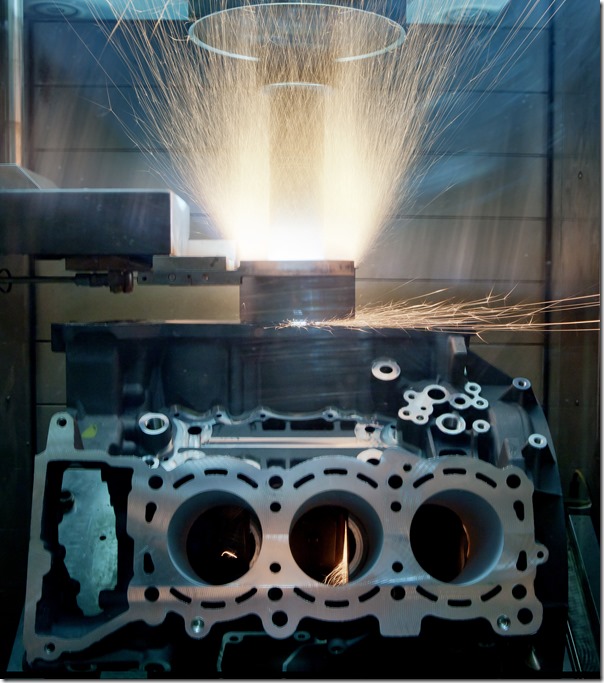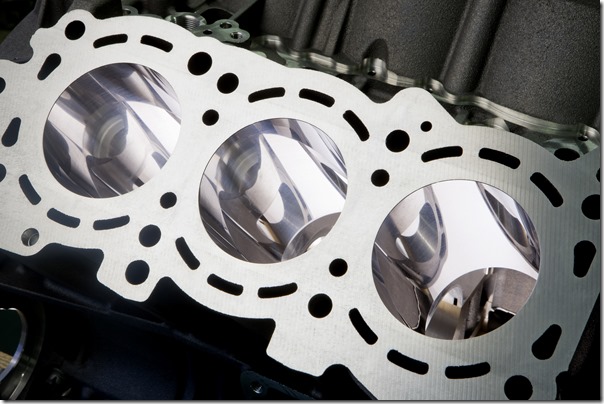Cylinder Coating for Improved Performance
Generally, when OEMs produce aluminum engine blocks (aluminum rather than cast iron because cast iron weighs like cast iron), they insert sleeves into the piston bores—cast iron sleeves.
#aluminum
Generally, when OEMs produce aluminum engine blocks (aluminum rather than cast iron because cast iron weighs like cast iron), they insert sleeves into the piston bores—cast iron sleeves. But not all vehicle manufacturers are doing this.
Daimler, in particular, as it worked in cooperation with Heller Machine Tools to develop an arc spraying process for coating cylinder bore surfaces (and aluminum crankcases) with a process they’re calling “NANOSLIDE.”
This year the company is using it in production of approximately one-million 4- and 6-cylinder engines per year at its facilities in Untertürkheim. (And other OEMs, including Renault and Nissan—which, not coincidentally, are working with Mercedes on engines—are using the process, as well.

The process works by melting iron/carbon wires that are lowered into the bore and then a nitrogen gas flow propels the melted particles (which are as hot as 2000° C) at a velocity of 60 to 80 m/sec.
While the process has been long used for small volumes—Daimler has been working on the process since 1998, when it was using it for AMG engines—Heller has “productionized,” in effect, the process, which it calls “CBC,” for Cylinder Bore Coating.
This is an entire process that is performed on a Heller MC20 machining center.
Entire, as in fine boring, roughening (texturing the surface for the spray), coating, rough honing, finish honing, and finish machining. According to the company the entire process—including block load/unload—can be performed on an eight-cylinder engine within six minutes. Once the coating is applied, an optical sensor, a Jenoptik IPS 100 bore inspector, is lowered into the cylinder and provides a 360° look at the condition of the surface, including any defects or porosities.
So what does this do for an engine?
It is lighter than a liner. Given the frictional characteristics of the surface, it helps improve engine performance, which contributes to better fuel economy. It helps reduce wear in engines over time.

RELATED CONTENT
-
Autonomy Picks Up Speed
The latest generation of the ProAI unit from ZF for autonomous vehicle technology is capable of processing inputs from multiple cameras, LiDAR and radar, as well as “paint” a 360-degree view around a vehicle, locate it on an HD map, and calculate a safe path through traffic, in no small part because it deploys the NVIDIA DRIVE Xavier, which is a processor that is capable of performing 30 deep-learning trillions of operations per section.
-
On BMW Tech, VW Golf R Variant, Hyundai Elantra, and More
The forthcoming BMW flagship SUV—the 2022 iX xDrive50—has a lot of tech, some that is deliberately discrete. The Hawaiians spend a lot of money for gasoline and it would be less if they’d electrify. Euro drivers like wagons—and apparently extreme driving in them. Stellantis is spending big on going electric. And even more.
-
7 Cool Tools: Laser Cutting, Fixture Modeling, and more
Increase operational productivity with these new developments for automotive manufacturing from Mazak, Renishaw, Omron, Marposs and more.


.jpg;width=70;height=70;mode=crop)








